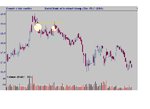barjon
Legendary member
- Messages
- 10,752
- Likes
- 1,863
Thanks to everyone who had a go. I hope contributors (especially Charlton who tabbed the down move and the bounce level) will excuse me for concentrating on another master class from mr.marcus.
Nope, there’s no spy-bots or trojans been in my computer, I’ve been scrupulous in not giving any hints as to what the instrument was , nor have I done anymore than pass the time of day with mr.marcus - so he must be a wizard then 😆 .
I’m quite sure that the greater the experience of the readers of this thread then the greater will be their admiration of Mark’s peer into the future - getting on for four months worth, I must remind you, with still more yet to unfold. Once again, I hope everyone appreciates the pure gold in Mark’s analysis. If all that’s not a tour de force then I don’t know what is.
I think it’s worth going through Mark’s narration against what did unfold. The price hung about for two days (maybe a little less than Mark anticipated) before falling to Mark’s blue line support where it held for six days - onward to Mark’s key number support (yes £18) where it bounced a bit higher than anticipated - then the dump down leg with only very brief support at Mark’s first red line level until it screamed to a halt virtually smack on Mark’s second red line support - the bounce here was stronger than Mark anticipated but, albeit in a more complicated fashion, the price went on to make Mark’s anticipated double bottom. Amazing 😱 .
So I’m left with little to say. I did this one because of the gap (first white circle) and musing whether this could be a breakaway gap, particularly when it was tested by the cut off point doji bar (itself created by an up gap - second white circle) and a prelude to a significant down move within the longer term range. With the failure to break the first gap a short entered just below the low of the doji bar seems reasonable with a stop just above the same doji bar high and an initial target at the light blue line.
As Split so rightly says, I hope these wot happened examples do point up situations where a low risk trade can be placed with the opportunity to run away quickly if things don’t pan out.
good trading
jon
Nope, there’s no spy-bots or trojans been in my computer, I’ve been scrupulous in not giving any hints as to what the instrument was , nor have I done anymore than pass the time of day with mr.marcus - so he must be a wizard then 😆 .
I’m quite sure that the greater the experience of the readers of this thread then the greater will be their admiration of Mark’s peer into the future - getting on for four months worth, I must remind you, with still more yet to unfold. Once again, I hope everyone appreciates the pure gold in Mark’s analysis. If all that’s not a tour de force then I don’t know what is.
I think it’s worth going through Mark’s narration against what did unfold. The price hung about for two days (maybe a little less than Mark anticipated) before falling to Mark’s blue line support where it held for six days - onward to Mark’s key number support (yes £18) where it bounced a bit higher than anticipated - then the dump down leg with only very brief support at Mark’s first red line level until it screamed to a halt virtually smack on Mark’s second red line support - the bounce here was stronger than Mark anticipated but, albeit in a more complicated fashion, the price went on to make Mark’s anticipated double bottom. Amazing 😱 .
So I’m left with little to say. I did this one because of the gap (first white circle) and musing whether this could be a breakaway gap, particularly when it was tested by the cut off point doji bar (itself created by an up gap - second white circle) and a prelude to a significant down move within the longer term range. With the failure to break the first gap a short entered just below the low of the doji bar seems reasonable with a stop just above the same doji bar high and an initial target at the light blue line.
As Split so rightly says, I hope these wot happened examples do point up situations where a low risk trade can be placed with the opportunity to run away quickly if things don’t pan out.
good trading
jon

